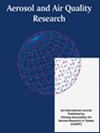温度与PM2.5对中风风险的影响:台湾卒中登记研究
IF 2.5
4区 环境科学与生态学
Q3 ENVIRONMENTAL SCIENCES
引用次数: 0
摘要
本文章由计算机程序翻译,如有差异,请以英文原文为准。
Risk of Stroke Associated with Temperature and PM2.5: Taiwan Stroke Registry-based Study
This study aimed to assess seasonal stroke risks related to temperature and PM 2.5 in Taiwan. Using data of the Taiwan Stroke Registry and air pollution monitored in 2006–2017, the researchers estimated daily average ischemic and hemorrhagic strokes according to temperature and PM 2.5 levels, evaluating stroke risks by categorizing PM 2.5 levels in each temperature zone. The results revealed a higher incidence of ischemic strokes in February and a higher incidence of hemorrhagic strokes in January, both decreased to the lowest in July. The study found that incident strokes increased with the PM 2.5 level in each temperature zone except for the 30+ ° C stratum. The highest incidence of ischemic strokes appeared at PM 2.5 greater than 37.0 µ g m –3 during 20–24 ° C, whereas the highest incidence of hemorrhagic strokes appeared at PM 2.5 greater than 37.0 µ g m –3 at less than 15 ° C. No adjusted RRs of strokes were significantly associated with PM 2.5 in all temperature zones after controlling for sex, age, BMI, smoking and drinking. We conclude that stroke incidence decreases as the weather gets warmer, whereas PM 2.5 pollution may have little effect on stroke incidence. It is essential to keep warm during cold days.
求助全文
通过发布文献求助,成功后即可免费获取论文全文。
去求助
来源期刊

Aerosol and Air Quality Research
ENVIRONMENTAL SCIENCES-
CiteScore
8.30
自引率
10.00%
发文量
163
审稿时长
3 months
期刊介绍:
The international journal of Aerosol and Air Quality Research (AAQR) covers all aspects of aerosol science and technology, atmospheric science and air quality related issues. It encompasses a multi-disciplinary field, including:
- Aerosol, air quality, atmospheric chemistry and global change;
- Air toxics (hazardous air pollutants (HAPs), persistent organic pollutants (POPs)) - Sources, control, transport and fate, human exposure;
- Nanoparticle and nanotechnology;
- Sources, combustion, thermal decomposition, emission, properties, behavior, formation, transport, deposition, measurement and analysis;
- Effects on the environments;
- Air quality and human health;
- Bioaerosols;
- Indoor air quality;
- Energy and air pollution;
- Pollution control technologies;
- Invention and improvement of sampling instruments and technologies;
- Optical/radiative properties and remote sensing;
- Carbon dioxide emission, capture, storage and utilization; novel methods for the reduction of carbon dioxide emission;
- Other topics related to aerosol and air quality.
 求助内容:
求助内容: 应助结果提醒方式:
应助结果提醒方式:


